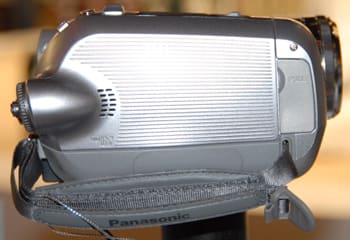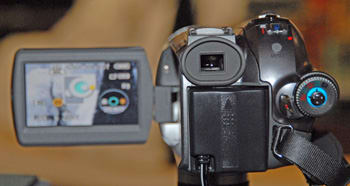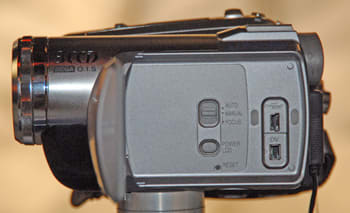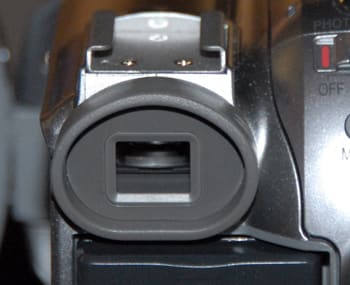Performance
The new GS300 shoots video in both normal and anamorphic widescreen aspect ratios at 29.97 frames per second (60i) for compatibility with the NTSC standard. For our readers who use the PAL TV standard, you will be able to buy a GS300 that will work with your TV system. The GS300’s widescreen video is cropped from the full width of the 4:3 CCDs and then zoomed to fit a 16:9 aspect ratio before being squeezed into anamorphic pixels. The GS300 does not widen its field of view in widescreen mode. In contrast, the higher-end GS500 widens the footprint it takes from the CCDs to create its widescreen, and thus produces more of the field on either side of a normal frame. Nevertheless, the video quality in both normal and widescreen modes on the GS300 is excellent, just like last year's GS250, which earned itself a CamInfo Select award.
Low Light Performance
Since the GS300 is essentially a body update to the GS250, the CCD sensitivity stays the same. According to Panasonic, the minimum light sensitivity of the GS300 is 12 lux. For MagicPix mode, a low light sensitivity of 0 lux is listed, but this of course takes into account additional light from the LCD; in this mode the LCD is supposed to be swiveled away from the videographers and towards the subject as a makeshift video light. This mode also slows the frame rate to a crawling 8 fps, which causes severe blurring if any subjects are moving.
We could not convince everyone the trade show floor to shut off the lights, so we couldn’t get in a quick test of the GS300’s low light ability.
Format
Compression
The PV-GS300 is a MiniDV cam, so it records video using the DV codec. Digital Video is compressed in a 5:1 ratio (or about 500 percent) and provides a 25 Mbps interleaved audio and video stream. Both SP and LP modes are offered. Stills are captured as JPEGs and saved to an SD card.
**Media
**A MiniDV cam, by definition, uses MiniDV tapes. The GS300 can also record stills to an SD (Secure Digital) card, which currently range is capacity from 32MB to 2GB.
**Editing
**For editing, Panasonic supplies two different applications. MotionDV Studio 5.6LE permits capture and editing of DV. MotionDV studio can capture video over DV (FireWire/i.Link) or USB 2.0 high speed and edit it in either normal or widescreen aspect ratios. A new application for beginners called Quick Movie Magic (Sweet Movie Life outside North America) makes it easy to edit using onscreen guidance. The software is compatible with Windows XP SP2.
Tour

**The Front
**Looming large on the face of this compact camcorder is its 10x Leica Dicomar lens with 37mm filter threads. Like last year's GS150, the lens has an integrated lens cap. The lens has a focal length of 3.0 to 30mm which gives a 35mm equivalent of 45.6 to 456mm in normal video, 46.7 to 467mm in widescreen, 43.4 to 434mm in 4:3 stills, and 47 to 470mm in 16:9 stills. Iris can be adjusted from f/1.8 to f/16. There is a standard Panasonic zoom microphone below the lens. To the left of the lens is the photoflash which has been molded into the curving lines of the camcorder body.

**The Right Side
**At the front of the right side, under a rubber cover, is the A/V multi-jack and the wired remote/microphone jack. The A/V multi-jack uses a special connector to combine the left and right audio, composite video, and S-Video inputs and outputs. Sadly, the GS300 *does not* support A/V-in for recording onto tape (analog-to-digital conversion), nor will it pass analog video through the DV output to allow you to convert your analog video sources to digital (analog-to-digital pass through). Last year's GS250 has both features.
Like all the Panasonic 3 CCD camcorders, the microphone jack will accept a low impedance, unbalanced microphone and provides plug-in power for electret (condenser) elements. There is no headphones jack. This will prove to be a difficult problem in using external microphones because their output level is too high and needs to be adjusted downward to avoid distortion. However, with no audio level adjustments like the GS500 and no headphones jack like the GS180, there is no way to monitor the effects of external level controls on the volume of recorded audio. Users will just have to use trial and error to find a compatible setting. Not cool, Panasonic.

**The Back
**The upper left of the back is home to the GS300’s electronic viewfinder (EVF), situated below the accessory shoe. It does not tilt like the eyepiece on the GS500, though it does pull out about 1 1/2 inches. To the right of the EVF eyepiece is the on-off slider which combines with a menu selection to offer a mode where the camcorder starts up in 1.7 seconds. The menu button is below this. Menus are viewable on both the EVF and LCD.
The mode dial is below and to the right of the menu button. In its center is a joystick control; this is used for menu navigation and selection. The surrounding mode dial itself lets users access the following modes: record (video), record (stills), playback (video), playback (stills), and PC, which permits stills to be transferred from the SD card to a computer over USB. Below the mode dial is the record/pause button for recording video. The back of the GS300 is also home to a speaker, so users may listen to the playback of captured audio.
The battery is to the left of the video recording button and below the eyepiece, which is a traditional and logical spot for it. We could not test batteries at CES. We do know that the GS300 is compatible with the CGA-DU series of batteries from 2005, so it should be relatively easy for users to locate a backup battery.

**The Left Side
**Panasonic has provided the GS300 and the GS500 with new 2.7-inch, widescreen LCDs. The LCD takes up most of the left side of this compact camcorder. When opened, it can be rotated fully along its horizontal axis, which allows subjects to watch themselves on the LCD screen as they are being taped. The LCD can also be put in the traditional position, flipped out 90 degrees. In the LCD cavity you’ll find the auto / manual focus switch, the reset button, the power LCD button, and ports for USB 2.0 high speed and DV (FireWire, i.Link, or IEEE1394, by other names). Otherwise, the left side is unmarred by buttons or connectors. Underneath the LCD recess is the SD card slot used for capturing still pictures. The GS300 can take SD cards as large as 2GB.
**

The Top
**The top of the GS300 is much like the top of the GS180. Then again, these cams are extremely similar. On the right front of the GS300 is the cassette mechanism release lever; push it forward to unlatch and open the clamshell, and the MiniDV loading dock rises and opens. Moving back, users will find an accessory shoe that is cold, just like the shoe on the GS180. Further back than this is the electronic viewfinder (EVF) eyepiece. The eyepiece can be pulled out to keep the user from resting his or her cheekbone on the battery. The eyepiece does not tilt upwards like the one on the GS500. To the right of the accessory shoe is the zoom slider / volume control. In back of the zoom slider is the photoshot pushbutton.
Auto / Manual Controls
**
Picture & Manual Control**
Automatic Control
Automatic controls on the PV-GS300 are similar to the GS180. The camcorder maintains exposure by controlling shutter, focus, and iris. Point-and-shooters will have no problem using this camcorder. Automatic controls are decent on most Panasonics, but rarely do they achieve the speed or precision of a Sony camcorder. Manual control is where Panasonic truly shines in the consumer market.
*Overall Manual Control
*Like all Panasonics, the GS300 has excellent manual controls. Via navigation and selection with the joystick, users can control iris, shutter, zoom, white balance, focus, and flash brightness. This system is less cumbersome than a touch screen system, but still a little awkward. The joystick has not changed since last year’s models, which received mixed reviews from users.
*Zoom
*The GS300 has zoom specs identical to its younger sibling: a 10x optical zoom with a 700x digital zoom that can be capped at 25x. The zoom toggle is a sliding switch-type, identical to last year’s. Some users found this an acceptable alternative to a zoom ring; others did not like the way the switch could tilt the camcorder’s body back and forth, upsetting the picture. No Panasonic consumer camcorder this year will feature a zoom ring.
*Focus
*The camcorder’s electronic sensors control focus in auto mode; the users may adjust focus with the joystick when the GS300 is in manual mode. The loss of the focus ring from last year’s GS250 is a hard blow, however.
*Exposure (Aperture)
*The aperture on the PV-GS300 ranges from f/1.8, f/2.0, f/2.4, f/2.8, f/3.4, f/4.0, f/4.8, f/5.6, f/6.8, f/8.0, f/9.6, f/11, f/14, and f/16, in both still and video mode. This is the same range as that on the PV-GS180.
*Shutter Speed
*In video mode, this camcorder has a good shutter speed range of 1/60, 1/100, 1/120, 1/180, 1/250, 1/350, 1/500, 1/750, 1/1000, 1/1500, 1/1/2000, 1/3000, 1/4000, and 1/8000 of a second. Still mode offers speeds ranging from 1/30 to 1/2000 of a second, which is not as good; dedicated still cameras frequently have shutter speeds of 2 seconds or longer. This camcorder is not a suitable replacement for a good still camera.
*White Balance
*The PV-GS300 has the standard Panasonic white balance options available: auto, indoor, outdoor, fluorescent lighting, and manual. We would be surprised with anything less. The manual white balance is accurate, and the camcorder makes it obvious to even beginning users when the process is complete.
*Gain
*Gain, an artificial boost to the video signal, can be tweaked on the PV-GS300. The user can adjust gain in 1dB increments up to 18dB of gain. However, the display doesn’t show a visible change in gain until 3dB have been added or subtracted.
Still Features
**

Still Features**
Once an SD card is inserted into the appropriate slot, stills can be recorded in 4:3 mode in sizes of 2048 x 1512, 1600 x 1200, 1280 x 960, and 640 x 480 pixels. A 1280 x 960 still may be taken while simultaneously recording video. A new feature on this year's camcorders is the ability to shoot widescreen stills as well; the GS3300 shoots widescreen stills in sizes of 2048 x 1152 and 640 x 360. As mentioned earlier, the shutter speed range in this mode is 1/30 to 1/2000 of a second, which could be more expansive. Still picture mode offers all of the manual controls present in video mode: white balance, iris, shutter, and focus. Last year’s PV-GS250 produced beautiful, crisp stills at the same resolution sizes, though the widescreen stills are new.
Handling and Use
Handling
The GS300 is a sub-compact camcorder and feels that way in the hand. It is very similar to the GS150 in size and weight. People with small hands will find it a comfortable fit. The next model down, the GS180, is even smaller.
Like all Panasonic 3 CCD camcorders, the GS300 is designed to be held cradled in the palm of the right hand with the forearm raised vertically. In the shooting position, the zoom slider and photoshot button are directly under the index finger. The right thumb can easily access the joystick control for setting functions like fade, and the record/pause button is nearby and also readily accessible. Manual focus adjust is accomplished by using the right thumb on the joystick. Not only is the joystick a touch awkward for most of us, but southpaws in particular are going to find this joystick setup a little inconvenient.


**LCD/Viewfinder
**The color LCD on the PV-GS300 is the same 2.7 inch 123,000 pixel screen as that used on the GS500. The PV-GS180, on the other hand, offers only 2.5 inches on LCD. The GS300’s LCD displays widescreen video in the correct 16:9 aspect ratio. Normal aspect ratio video (4:3) is pillar boxed (meaning vertical black bars are placed on either side) when displayed. This means that the LCD display offers the user a visual indication of which aspect ratio the camcorder is currently shooting in - a nice bit of engineering.
Panasonic has always provided a lot of information on its screens; the GS300 continues that tradition. The degree of information displayed is selectable in the menus. The EVF is also in color and functions similarly to the EVF on the GS500. User can withdraw the EVF eyepiece so the eye can be positioned away from the protruding battery. However, it does not tilt upwards, which may cause problems if you want to use the EVF while the camcorder is on a tripod.
Audio / Playback / Connectivity
Audio
Panasonic's standard zoom stereo microphone system is used to capture audio in either 12 bit or 16 bit resolution. Users can also attach an external unbalanced microphone with the 3.5mm microphone jack; once it’s attached, the camcorder’s internal microphones are automatically disconnected. Audio can be played back and assessed through the small speaker on the GS300’s rear. The zoom slider control towards the top of the rear controls the volume.
**VCR Mode
**Panasonic’s VCR mode can be used for reviewing footage in-camera, controlling footage seen on a TV when connected to the cam via A/V cable, or for copying the video to a computer over either DV (FireWire or i.Link) or USB cables. Users may play, pause, fast forward, and stop playback using the joystick; they may also fast preview, fast reverse, and fast reverse preview.
**Ports
**Like the PV-GS500, the GS300 has DV, USB 2.0 high speed, A/V, and a shared microphone/wired remote port.
Other Features
**Other Features
***AGS* - Panasonic has included a new feature on this year's 3 CCD camcorders with OIS, called AGS (the acronym is never explicitly decrypted, despite our questioning). Basically, AGS is an intelligent sensor that detects, from the camcorder's position or from a prolonged period of no motion, when a user forgets to stop recording. At this point, AGS places the camcorder in standby. This detection minimizes wastage of tape and battery charge. AGS is turned off by default but may be activated via a menu selection.
Comparisons / Conclusion
**
Conclusion
**A 2005 CamInfo Select camcorder, the PV-GS250 has been shrunk into a smaller body to create the new PV-GS300. This seems to have occurred without decreasing any of the video quality that made it a winner last year. The new size and optical image stabilization will appeal to many. It certainly sets a new price point for camcorders with OIS at $699. The lack of a headphone jack, however, is a significant omission in what is otherwise a nicely configured 3 CCD camcorder. Yet even without the headphone jack, this camcorder will likely be in competition again for the top choice in its price range. I expect the PV-GS300 to be a popular selection for users who want OIS stability and 3 CCD quality at a budget price.
Meet the tester

Guy Bruner
Editor
Guy Bruner is a valued contributor to the Reviewed.com family of sites.
Checking our work.
Our team is here for one purpose: to help you buy the best stuff and love what you own. Our writers, editors, and lab technicians obsess over the products we cover to make sure you're confident and satisfied. Have a different opinion about something we recommend? Email us and we'll compare notes.
Shoot us an email